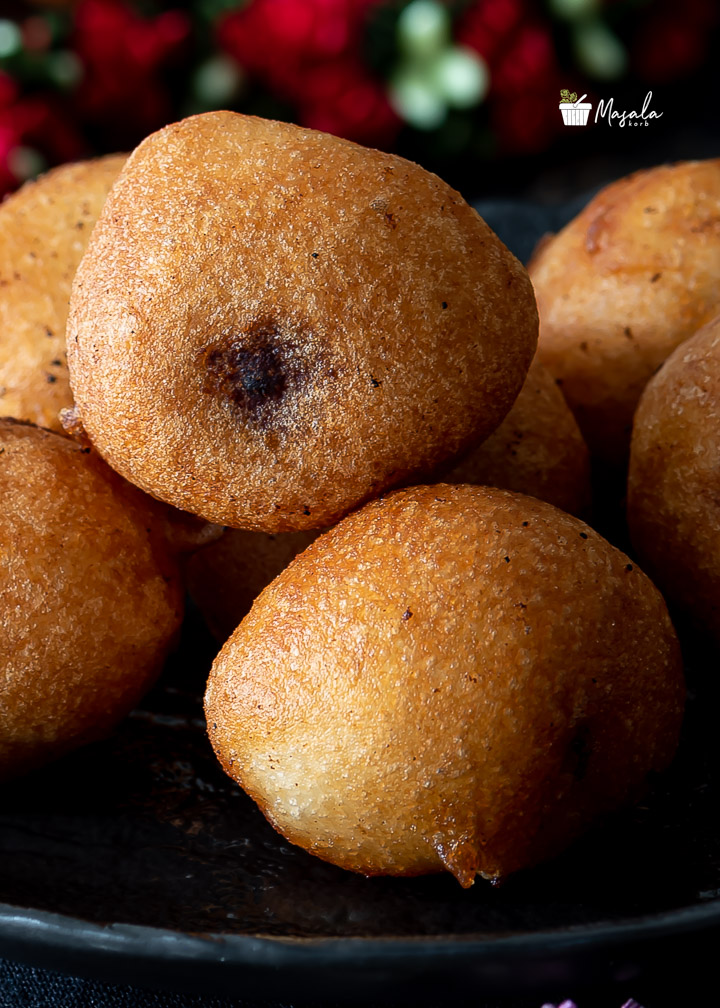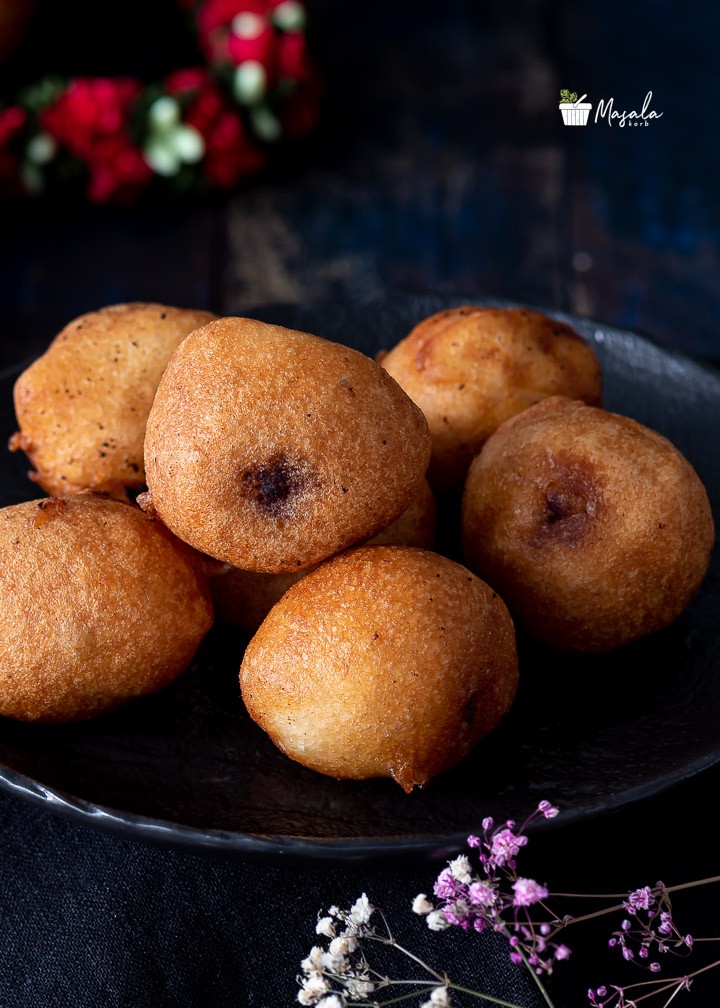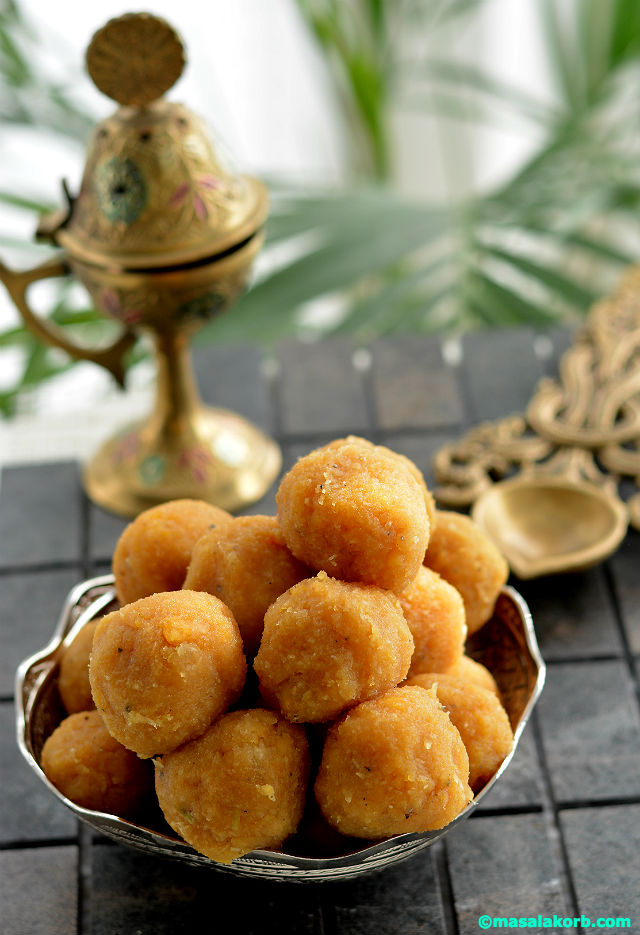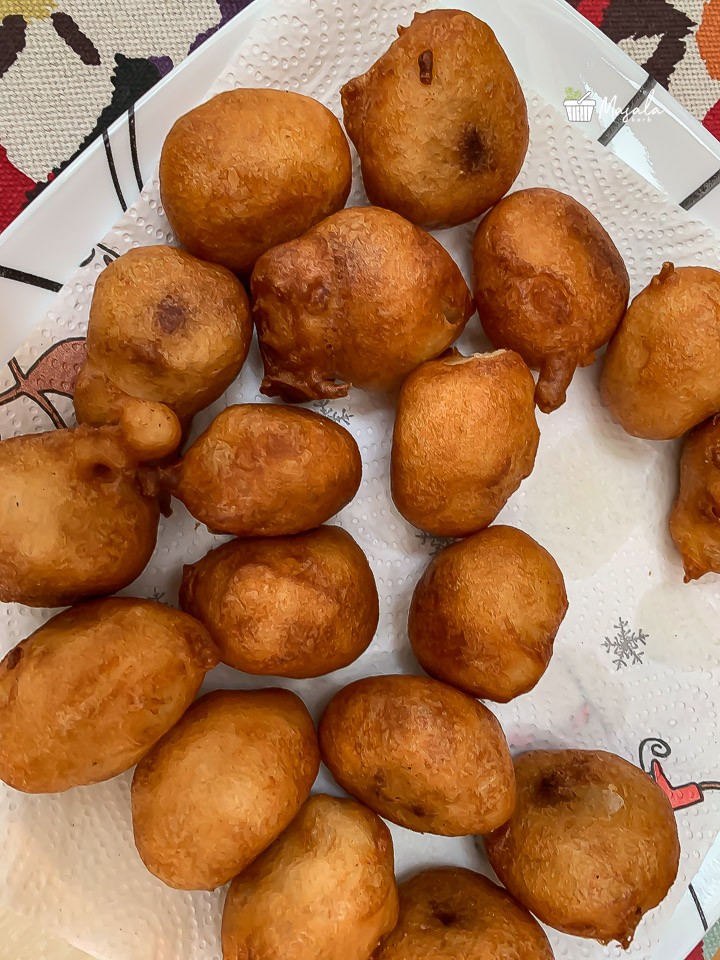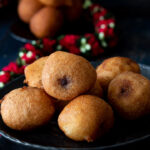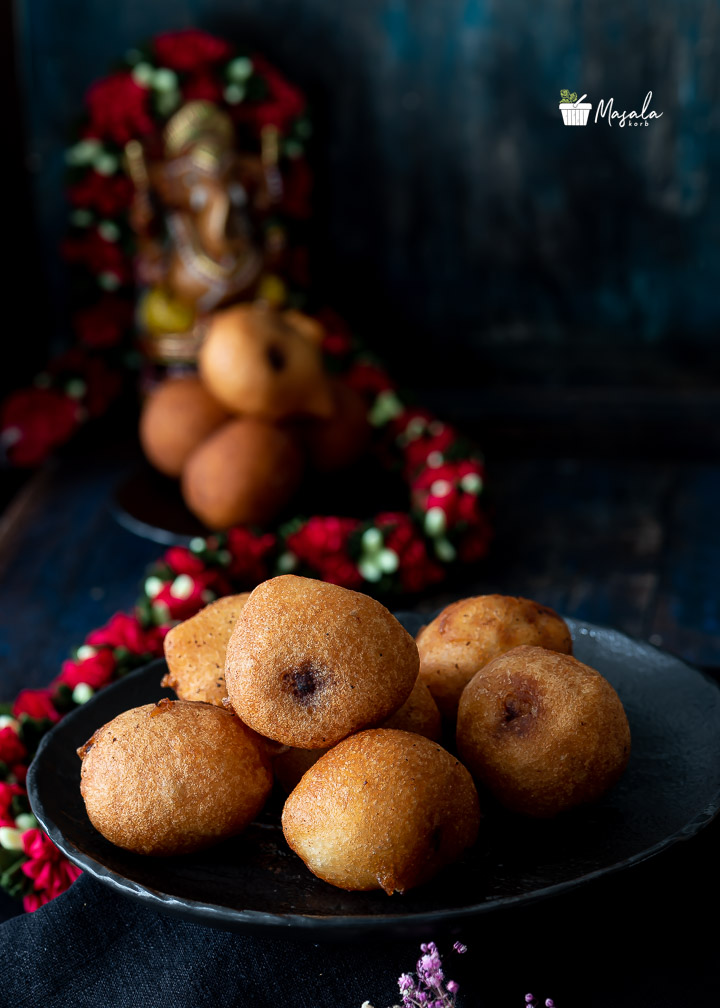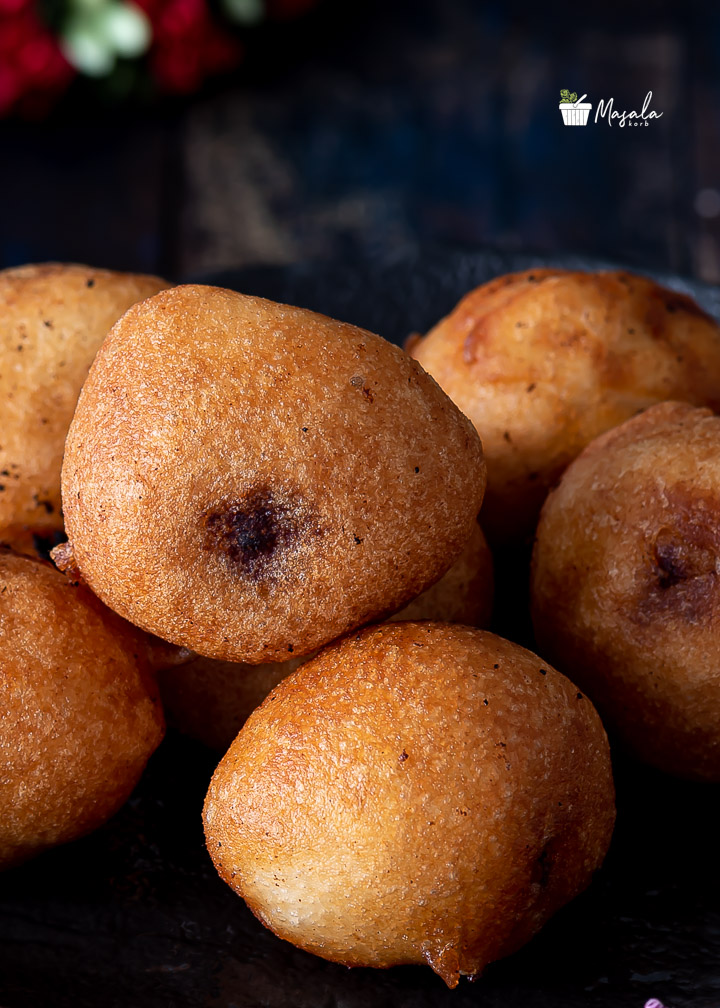Poornam Boorelu Recipe | How to prepare Poornalu | Purnam Burelu – Poornam Boorelu or Poornalu, a popular delicacy in Telugu Cuisine & is traditionally prepared with rice-urad dal batter and the dumplings are stuffed with an aromatic coconut and channa dal mixture known as poornam and it is deep-fried in oil.
Editor’s note: This post was originally published in January 2016 and has been updated with Video and replaced with better edited pictures for comprehensiveness and freshness.
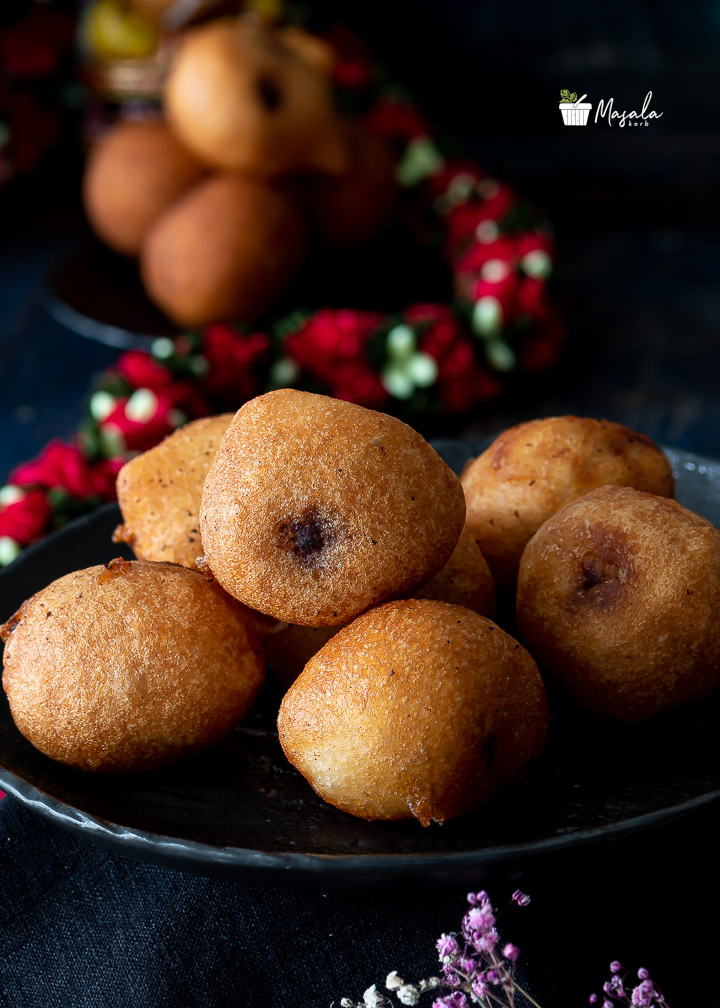 Poornam Boorelu Recipe for making Poornalu, a popular delicacy in Telugu Cuisine, which would certainly top the list when it comes to a hearty feast during festivals, weddings and any other special occasions. These are known with different names in different regions of India- To name a few sukhiyan, suyam, susiyan, seeyam, suzhiyam, sugeelu or sugunta. A regular hit during all Telugu festivals, poornalu are joyously prepared and enjoyed in all households.
Poornam Boorelu Recipe for making Poornalu, a popular delicacy in Telugu Cuisine, which would certainly top the list when it comes to a hearty feast during festivals, weddings and any other special occasions. These are known with different names in different regions of India- To name a few sukhiyan, suyam, susiyan, seeyam, suzhiyam, sugeelu or sugunta. A regular hit during all Telugu festivals, poornalu are joyously prepared and enjoyed in all households.
Poornam Boorelu Recipe is traditionally prepared with rice-urad dal batter and the dumplings are stuffed with an aromatic coconut and channa dal mixture known as poornam and it is deep-fried in oil. This delicacy is a must during Sankranti – the harvest festival in India. The same filling can also be used to make bobbatlu, also known as puran poli. Check out the recipe for bobbatlu!!
Click on the link to know more about how Makar Sankranti is celebrated back home!!
What is the filling for Poornalu
The fillings and the outer coverings differ from place to place for Poornam Boorelu Recipe. While many use chana dal, coconut or a mix of both as filling for this, you can also use toor dal or moong dal in the filling and prepare in the similar manner. The outer covering is made up of lots of variations like urad dal batter, maida (all purpose flour) batter and rice-urad mixture (like we make at home) and even the proportions might be different in various households. Some of them even ferment the rice-urad dal batter before making poornalu but we don’t. Today I will be sharing exactly how my mother makes at home all these years.
Also, as there is so much awareness about reducing cholesterol and avoiding deep-frying, I instantly got an idea of making poornalu in a paniyaram pan. So, next time I’m going to try n make kobbari poornalu in a paniyaram pan. I have almost stopped deep-frying for a couple of years now, it has actually resumed only after I started my blog!!
Off to Poornam Boorelu Recipe!!
Easy Steps to follow for
Poornam Boorelu Recipe
The main steps for Poornam Boorelu Recipe include preparing-
- Batter for the outer covering
- Filling or Poornam
- Deep-frying poornalu in oil
Preparing Batter for Outer Covering:
- Soak rice and lentils separately for 5 to 6 hours or overnight.
- Wash soaked rice and dal and drain away the water.

- Add required water while grinding the lentils first to a smooth textured batter.
- Take care that the batter is neither thick nor thin. I’m using an ultra wet grinder.
- Remove the lentils batter to a large bowl and now similarly grind the rice to a smooth batter.
- Remove this batter to the same bowl and mix both the batters using your hands adding salt to it. It should be similar to dosa batter consistency. Set aside in the refrigerator and prepare the filling.
NOTE:
- You can also soak both rice and lentils together and grind.
- You can also prepare the filling first, then grind the batter and use it right away. Either ways is fine.

Let’s prepare Filling or Poornam:
- Wash and soak Bengal gram dal (minimum ½ an hour).
- Discard soaked water, add 2 cups of fresh water to the drained dal and pressure cook over high heat for 3 whistles. Then simmer to low heat for 5 minutes and turn off the heat.

- Open the pressure cooker once the pressure subsides. Drain any excess water in the dal and mash it.
- Take jaggery powder in a saucepan and add ½ cup of water to it.
- Heat over medium heat till the jaggery melts and comes to a boil. Turn off the heat. (This is mainly done to remove any impurities in the jaggery),

- Transfer cooked lentils to a wide pan,
- To this add ½ cup of desiccated coconut.
- Now strain jaggery syrup into the mixture in the pan.

- Cook the mixture over medium heat till all the moisture evaporates.
- You get a thick consistency as shown in the pic below. Now turn off the heat.
- Add cardamom powder and mix well. Let the mixture cool completely.
- Make small size balls out of the mixture and set aside.
Deep Frying Poornam Boorelu:
- Remove the rice-lentil batter from the refrigerator, add salt to taste and mix well.
- Meanwhile heat oil in a deep frying pan or kadai over medium heat.
- To test if the oil is hot enough, drop a few drops of the batter in it. The batter drops should immediately rise to the top and sizzle.
- Drop a ball of the filling into the batter and you can start making the poornalu.

- Dip each ball of stuffing (poornam) in the batter carefully using fingers or a spoon and coat it well and swipe off the excess drippings.
- Drop them gently into hot oil. Ensure the Poornam is completely covered. I usually use my fingers but today I had to use a spoon because I had to click pictures.

- Pour oil using the slotted spoon from the sides (like how we do for vadas) which helps in puffing up the poornalu.
- Turn it to the other side and fry until light golden brown.

- You can repeat frying for a minute or two for an extra crust.
- Serve them hot/cold or at room temperature. I love to have them hot with a dollop of ghee in the centre after you break open the dumpling.
Poornam Boorelu Recipe | How to Prepare Poornalu | Purnam Burelu
Ingredients
Batter for Outer layer:
- 1 Cup Urad dal Black Gram Dal
- 2 Cups Raw Rice regular sona masoori
- Salt to taste
For the filling or Poornam:
- 1 Cup Split Bengal Gram Chana Dal or Chanaga Pappu
- 2 Cups Water to pressure cook lentils
- ½ Cup Desiccated Coconut
- 1½ Cups Powdered Jaggery
- ½ Cup Water to dissolve jaggery
- 1 tsp Cardamom Powder
To Deep Fry:
- Required oil for deep-frying
Instructions
Batter for Outer Covering:
- Soak rice and lentils separately for 5 hours or overnight.
- Wash soaked rice and dal and drain away the water.
- Add required water while grinding the lentils first to a smooth textured batter.
- Take care that the batter is neither thick nor thin. I'm using an ultra wet grinder.
- Remove the lentils batter to a large bowl and now similarly grind the rice to a smooth batter.
- Remove this batter to the same bowl and mix both the batters using your hands adding salt to it. It should be similar to dosa batter consistency. Set aside in the refrigerator and prepare the filling.
Preparing Filling or Poornam:
- Wash and soak Bengal gram dal (minimum ½ an hour).
- Discard soaked water, add 2 cups of fresh water to the drained dal and pressure cook over high heat for 3 whistles. Then simmer to low heat for 5 minutes and turn off the heat.
- Open the pressure cooker once the pressure subsides. Drain any excess water in the dal and mash it.
- Take jaggery powder in a saucepan and add ½ cup of water to it.
- Heat over medium heat till the jaggery melts. Turn off the heat. (This is mainly done to remove any impurities in the jaggery)
- Transfer cooked lentils to a wide pan,
- To this add ½ cup of desiccated coconut.
- Now strain jaggery syrup into the mixture in the pan.
- Cook the mixture over medium heat till all the moisture evaporates.
- You get a thick consistency as shown in the pic below. Now turn off the heat.
- Add cardamom powder and mix well. Let the mixture cool completely.
- Make small sized balls out of the mixture. And set aside.
Deep-frying Poornam Boorelu:
- Remove the batter from the refrigerator and add a pinch of soda and mix well.
- Mean while heat oil in a deep frying pan or kadai over medium heat.
- Once the oil is hot enough, do a test with a pich of the batter. If the oil is hot enough the batter rises to the top immediately.
- Dip each ball of stuffing (poornam) in the batter carefully using fingers or a spoon and coat it well and swipe off the excess drippings and drop them gently into hot oil. Ensure the Poornam is completely covered. I usually use my fingers but today to click pictures, I had to use a spoon.
- Pour oil using the slotted spoon from the sides (like how we do for vadas) which helps in puffing up the boorelu nicely.
- Turn it to the other side and fry until light golden brown.
- You can repeat frying for a minute or two for an extra crust,
- Serve them hot/cold or at room temperature. I love to have them hot,
Recipe Video
Notes
- Batter for the outer layer should neither be thick nor very thin. The Udad dal batter should be thicker than a dosa batter, but slightly thinner than Idli batter.
- If the outer layer is very thick it will reduce the sweetness of poornalu as the outer layer would be thick.
- If the batter is of thin consistency, the Boorelu will disintegrate.
- In case your batter becomes runny, you can save it by mixing little rice flour to the batter and bring it to the right consistency. But do not use too much, it will result in hard poornalu. This will make the outer covering slightly hard based on how much flour is used.
- While cooking channa dal, take care not to over cook it. Cooked dal should be firm to touch and should be cooked completely.
- The consistency of the filling should be little tight (not very soft) otherwise there is possibility that the filling might come out of the outer layer and may splutter while frying them.
- If your filling is slightly soft then try to refrigerate it for few hours or you can even microwave the mixture for a minute and leave it aside. This will help in hardening the mixture a bit.
- Fry the Boorelu in hot oil, otherwise the batter will absorb a lot oil.
- For a Vegan version avoid ghee in the recipe.
Below are some popular festival recipes from blog:
- Rava Kesari Bath
- Rava Puri or Sojjappalu
- Mango Kesari or Sheera
- Bobbatlu or Puran Poli
- Coconut Obbattu
- Kobbari Poornam
- Rajma Sundal
- Allam Garelu
Do check out other UGADI RECIPES, FESTIVAL RECIPES and DESSERT RECIPES.
Hungry for more? Never miss a recipe!!…Subscribe to MasalaKorb and have posts delivered straight to your inbox! And connect with me on Facebook, Google, Twitter, Instagram and Pinterest for all of the latest updates.
Do subscribe to my YouTube Channel for latest video alerts!!
Did you make a recipe? Make sure to tag your photo with this hashtag: #masalakorb
Happy Cooking
Cheers!!
Padma.

